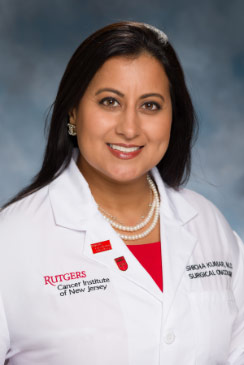 Breast cancer affects one out of every eight women. That’s over 240,000 women in the United States each year. So, when you feel pain or tenderness in your breast, you may be worried that it could be something serious. Shicha Kumar, MD, FACS, Surgical Oncologist at Rutgers Cancer Institute of New Jersey and RWJUH, an RWJBarnabas Health facility, assures you that it probably isn’t. “Breast pain is very common,” said Dr. Kumar. “Up to 70 percent of women will have some complaint of breast pain over her lifetime. Breast pain is not commonly associated with breast cancer.”
Breast cancer affects one out of every eight women. That’s over 240,000 women in the United States each year. So, when you feel pain or tenderness in your breast, you may be worried that it could be something serious. Shicha Kumar, MD, FACS, Surgical Oncologist at Rutgers Cancer Institute of New Jersey and RWJUH, an RWJBarnabas Health facility, assures you that it probably isn’t. “Breast pain is very common,” said Dr. Kumar. “Up to 70 percent of women will have some complaint of breast pain over her lifetime. Breast pain is not commonly associated with breast cancer.”
RWJBarnabas Health together with the Rutgers Cancer Institute, New Jersey’s leaders in cancer care, bring a world-class team of researchers and specialists to fight alongside patients, providing close-to-home access to the latest technologies and treatments including clinical trials.
“Breast pain, or what’s clinically known as mastalgia, can be a huge source of anxiety for women,” said Dr. Kumar. “And usually, needlessly so. In fact, the presence of breast cancer in a patient that presents with only pain is extremely low, less than three percent. Although women generally do not have to worry about breast pain, I encourage all women to see their doctor if they notice any changes in their breast or feel discomfort – even as a precautionary measure.”
Causes of Breast Pain
Your doctor will likely tell you that your breast pain is one of three things: cyclical breast pain, noncyclical breast pain or unrelated breast pain. Cyclical breast pain is the most common type of breast pain and occurs in conjunction with a woman’s hormone cycle.
“Premenopausal women are most likely to experience cyclical breast pain,” said Dr. Kumar. “This type of breast pain is caused by the typical hormonal changes associated with menstruation that causes proliferation or growth of your normal breast tissue.”
Less common than cyclical breast pain is noncyclical breast pain and is not related to a woman’s menstrual cycle.
“Noncyclical breast pain is a sign that something else is going on in the breast,” said Dr. Kumar. “Again, usually not cancer. It could be cysts, an infection or inflammation or simply due to diet, lifestyle or breast size. Women who are less active and women with larger breasts tend to have more pain.”
The final type of breast pain is a pain that might not be associated with the breast tissue at all. Sometimes an injury or other condition can feel like it’s breast pain. It could possibly be a chest or musculoskeletal pain. Basically, an ache or pain may feel like it’s coming from the breast, but it can be coming from a different source entirely.
“The breast sits on top of the pectoralis muscle so weightlifting or even being a little bit more active than usual can cause some musculoskeletal pain that could feel like breast pain,” added Dr. Kumar. “You could also have referred pain that comes from nerve problems and even things like pneumonia can cause pain in the breast.”
In order to determine what the cause of the breast pain is, your doctor will ask about your menstrual history, the history of breast cancer in your family and perform a clinical exam
Finding Relief
Most breast pain will go away on its own, however 10 to 15 percent of women with breast pain may need some sort of intervention. Women may find relief from:
- Getting better support - wearing the appropriate bra size and wearing a supportive sports bra when working out
- Over the counter pain medicine like NSAIDS or an anti-inflammatory medication or gel
- Warm compresses or ice packs
- Gentle massage
“Everyone’s breasts are different,” said Dr. Kumar. “It can be trial and error for what works best for you.”
Other, less scientifically-validated treatments for breast pain may also be helpful. These include:
- A low-fat diet
- Increased exercise
- Avoiding caffeine
- Over the counter evening primrose oil
- Vitamin E
For women with debilitating breast pain that affects your quality of life and ability to perform normal everyday tasks, a doctor may be able to treat you with medication.
Getting Familiar with Your Breast Health
Dr. Kumar recommends that women perform regular breast self-exams and receive regular mammograms, starting at age 40.
“While we recognize that October is breast cancer awareness month, we also have to acknowledge that breast cancer is something to be aware of year-round,” said Dr. Kumar. “Get familiar with how your breasts look and feel and openly talk to your doctor when something concerns you.”
Together, RWJBarnabas Health and Rutgers Cancer Institute of New Jersey provide access to state-of-the-art breast cancer treatment including the latest clinical trials, minimally-invasive surgical procedures and multidisciplinary health care teams. To schedule a mammogram or for more information visit www.rwjbh.org/mammo. Let’s beat breast cancer together.